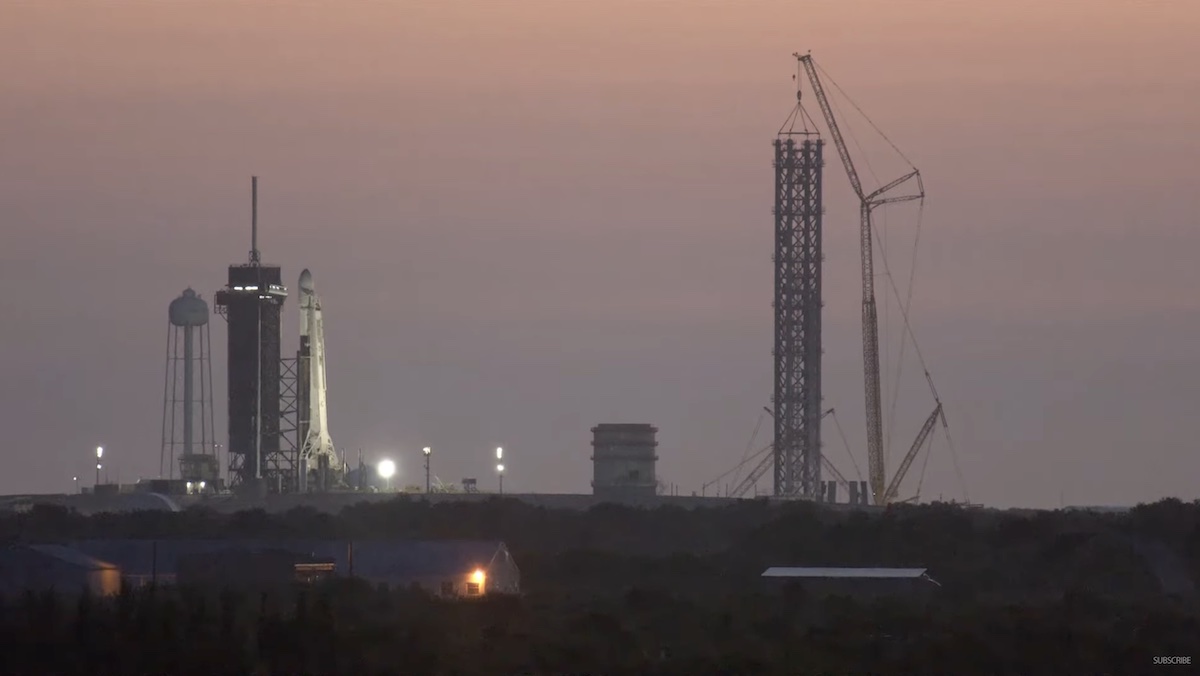
The 39th and 40th launches of the year from Florida’s Space Coast are set to blast off Saturday night and Sunday night, back-to-back missions to deploy more satellites for SpaceX’s Starlink internet network, plus a rideshare payload for AST Space Mobile’s planned space-based cellular broadband network.
Two Falcon 9 rockets will do the lifting. The first launch is set to launch at 9:10 p.m. EDT Saturday (0110 GMT Sunday) from pad 39A at NASA’s Kennedy Space Center. A few miles to the south of Kennedy, another Falcon 9 rocket is being readied for liftoff from pad 40 at Cape Canaveral Space Force Station at 10:53 p.m. EDT Sunday (0253 GMT Monday).
Both missions will add to SpaceX’s constellation of Starlink internet satellites. Thirty-four Starlink satellites are mounted atop the Falcon 9 rocket waiting blastoff Saturday night, and 54 more will launch Sunday night.
The new satellites will bring size of the the Starlink fleet to more than 3,000 spacecraft currently in orbit. SpaceX has launched 3,259 Starlink satellites to date, including testbeds and prototypes no longer in orbit, and the next two Starlink missions will bring that number to 3,347 spacecraft.
The launch Saturday will set a new record for rocket reuse, with a Falcon 9 first stage booster going for its 14th flight. The booster, designated B1058 in SpaceX’s inventory, debuted May 30, 2020, with the historic launch of SpaceX’s first astronaut mission on a Crew Dragon spacecraft.
The booster landed on a drone ship in the Atlantic Ocean after the crew launch in 2020. It’s flown 12 times since then, hauling a South Korean military satellite into space and launching a resupply mission to the International Space Station, two Transporter small satellite rideshare missions, and eight Starlink missions.
SpaceX has dispatched two of its rocket landing platforms from Port Canaveral into the Atlantic Ocean. The boosters flying Saturday and Sunday will target landings on each of the drone ships positioned a few hundred miles northeast of Cape Canaveral.
SpaceX rolled the Falcon 9 to pad 39A on Friday amid ongoing construction work to ready the seaside launch complex as a future base for SpaceX’s huge reusable Super Heavy booster and Starship rocket. Ground crews raised the 229-foot-tall (70-meter) Falcon 9 vertical early Saturday.
The 34 Starlink satellites for Saturday night’s mission are joined by BlueWalker 3, a prototype for a planned fleet of spacecraft built and owned by Texas-based AST SpaceMobile. AST SpaceMobile’s test satellite will unfurl an antenna array in low Earth orbit covering an area of 693 square feet (about 64 square meters). AST SpaceMobile aims to deploy additional spacecraft in 2023 to start building an operational network designed to link consumer cell phones via satellites.
“The launch of BlueWalker 3 is the culmination of years of effort by our engineers to let us test connecting the phone in your pocket, with no modifications to the phone, directly with one of our satellites in space,” said Abel Avellan, chairman and CEO of AST SpaceMobile, in a statement. “This revolutionary technology supports our mission to eliminate the connectivity gaps faced by more than 5 billion mobile subscribers today moving in and out of coverage, and bring cellular broadband to approximately half of the world’s population who remain unconnected. We want to close the gap between the digital ‘haves’ and ‘have nots’.”
BlueWalker3 is riding in the upper position inside the Falcon 9’s payload shroud. The Falcon 9’s upper stage will perform two engine burns before deploying the roughly 3,300-pound (1.5-metric ton) BlueWalker 3 satellite at an altitude of around 250 miles (400 kilometers). Separation of BlueWalker 3 is scheduled about 50 minutes after liftoff.
Two more engine burns by the Falcon 9 upper stage will maneuver the rocket into a slightly different orbit for deployment of 34 Starlink satellites at around T+plus 2 hours and 4 minutes.
The Falcon 9 launch Sunday is a dedicated flight for the Starlink network. It will place 54 Starlink satellites into orbit around 15 minutes after launch.
The back-to-back missions this weekend will be the 41st and 42nd SpaceX launches of the year.
Forecasters from the U.S. Space Force’s 45th Weather Squadron predict a 60% chance of favorable weather for Saturday night’s launch.
“The primary weather concerns for a Saturday attempt are the cumulus cloud rule, the anvil cloud rules, as well as the surface electric fields rule associated with the evening convection and storm interactions,” forecasters wrote in an outlook Friday.
There’s an 80% chance of good weather for launch Sunday night.
Email the author.
Follow Stephen Clark on Twitter: @StephenClark1.
from Spaceflight Now https://ift.tt/qjioYnZ
via World Space Info







0 comments:
Post a Comment